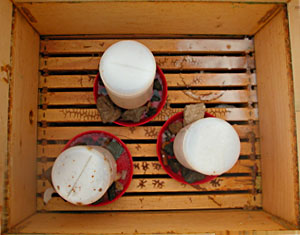 As much as I like to show you bees, on January 23, this is what I like to see.
As much as I like to show you bees, on January 23, this is what I like to see.These are bees on the down-low, clustered Carniolans in the Wilde hive who still have enough food in the hive to remain below the top level. Oh sure, I stop by and refill these feeders as necessary (if they will take sugar syrup, I will surely give it), but the weather has finally turned cold and they are not drinking much. Today it was 39 degrees F (about 4 degrees C) while I was on the roof, and these girls were all cuddled down inside, not a bee in sight. The little marks you see are dirty bits of much-travelled beeswax.
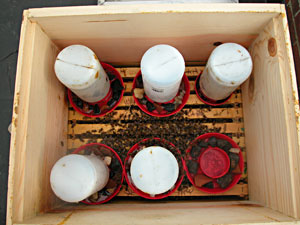 Now offered for your consideration: honeybees up top. This is the Twain family, big and bustling in the Fall, and perhaps too numerous for its own good now. They have burned through just about all the honey they had stored, but scarily have only taken two quarts of sugar syrup since the last time I came by. It's so cold, they may not be able to access enough of the food to keep from starving.
Now offered for your consideration: honeybees up top. This is the Twain family, big and bustling in the Fall, and perhaps too numerous for its own good now. They have burned through just about all the honey they had stored, but scarily have only taken two quarts of sugar syrup since the last time I came by. It's so cold, they may not be able to access enough of the food to keep from starving.Interestingly, their behaviour is reminiscent of the dearth days of August: around here, there is almost nothing for the bees to collect during the absolutely-crazy- hottest time of the year, and the bees get ornery. It's certainly not hot now, but some of that risibility is certainly present. I got a January sting last week from these girls (luckily it was on the ankle of the foot where I seem to have tendonitis, and it seems to have helped).
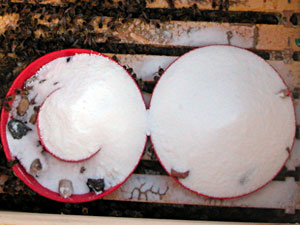 I decided to refill the two empty feeders in Twain, and to use the two feeder bases left over to hold dry dugar. The bases are stuck with propolis to the frames below, and I do not like knocking frames around when bees are clustered all over them.
I decided to refill the two empty feeders in Twain, and to use the two feeder bases left over to hold dry dugar. The bases are stuck with propolis to the frames below, and I do not like knocking frames around when bees are clustered all over them. The bees kept jumping in while I poured in sugar, so I would stop occasionally to root around with my finger and uncover them. You can see a couple of bee heads emerging in the picture, I think. The trouble with reaching into the hive is that dearth-y bees react more to everything, and some would try to take flight to defend their hive each time I reached in. It was cold enough that they would probably not be able to fly back, so I stopped reaching in, and tried to pick up and put back the bees I could find.
Apparently I had some stowaways on my veil and my tool bag, because I found bees inside, buzzing the windows, after I went back to the house. I opened the door and let them out, confident that a few minutes at room temperature allowed them to warm those wing muscles enough to fly back home.
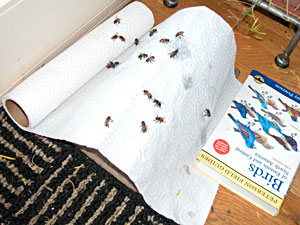 Few things in daily life hurt my heart like the cold, wet body of a honeybee victim of winter. There seem to be many more of them these days, in part because all of the beekeepers around here have to work hard now to keep putting sugar syrup out. The bees are running through their stores this winter because it is warm(er), they are more active, but there are no more flowers.
Few things in daily life hurt my heart like the cold, wet body of a honeybee victim of winter. There seem to be many more of them these days, in part because all of the beekeepers around here have to work hard now to keep putting sugar syrup out. The bees are running through their stores this winter because it is warm(er), they are more active, but there are no more flowers.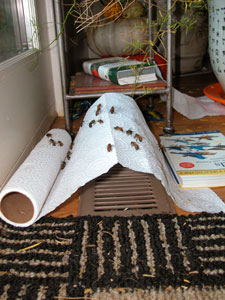 Place the towels carefully over a heating register or other gentle source of heat (a blow dryer would be too rough). I hold down the edges with heavy books.
Place the towels carefully over a heating register or other gentle source of heat (a blow dryer would be too rough). I hold down the edges with heavy books. 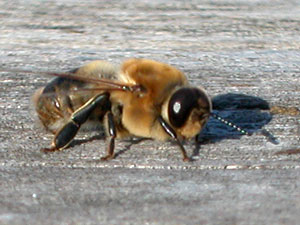 This is one very, very warm winter, apparently the warmest in over a century so far. The bees fly every day, so I fret over whether or not I can keep them fed until the flowers bloom (unless they bloom early, and risk death by frost when, or if, the winter arrives). I last fed the roof bees 6 days ago, so I trooped up there to see what they had eaten and refill the feeders.
This is one very, very warm winter, apparently the warmest in over a century so far. The bees fly every day, so I fret over whether or not I can keep them fed until the flowers bloom (unless they bloom early, and risk death by frost when, or if, the winter arrives). I last fed the roof bees 6 days ago, so I trooped up there to see what they had eaten and refill the feeders.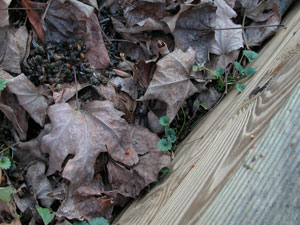 The second, but more heartbreaking sight was the return of dead bees around the Twain hive. The picture here is of dead bees in front of the Mill hive out in the 'burbs, though. Why is it here? Because I think that the two hives have a lot in common, including difficult-to-manage varroa infestations and signs of Paralytic Mite Syndrome (PMS). The varroa have probably been knocked down by now, which means their larval habit of crippling baby bee wings is less obvious. But the virus they have already imparted to the bees may be shortening lives. Both hives share the unique characteristic of major K-wings earlier in the season. I think it's PMS.
The second, but more heartbreaking sight was the return of dead bees around the Twain hive. The picture here is of dead bees in front of the Mill hive out in the 'burbs, though. Why is it here? Because I think that the two hives have a lot in common, including difficult-to-manage varroa infestations and signs of Paralytic Mite Syndrome (PMS). The varroa have probably been knocked down by now, which means their larval habit of crippling baby bee wings is less obvious. But the virus they have already imparted to the bees may be shortening lives. Both hives share the unique characteristic of major K-wings earlier in the season. I think it's PMS. But back to the out-of-season drone. Here's what his underside looks like. Can you see how lovely and fuzzy he is, particularly around his front legs? I'm kind of wowed by the scalloped pattern of his exoskeleton under there, so pretty. Do you notice that the base of his abdomen has a little golden cone-shaped outcropping rather than a stinger? That's why I could be so free in photographing him: he can only buzz at me. But I have a kind of freaky curiousity to show you, too.
But back to the out-of-season drone. Here's what his underside looks like. Can you see how lovely and fuzzy he is, particularly around his front legs? I'm kind of wowed by the scalloped pattern of his exoskeleton under there, so pretty. Do you notice that the base of his abdomen has a little golden cone-shaped outcropping rather than a stinger? That's why I could be so free in photographing him: he can only buzz at me. But I have a kind of freaky curiousity to show you, too. 